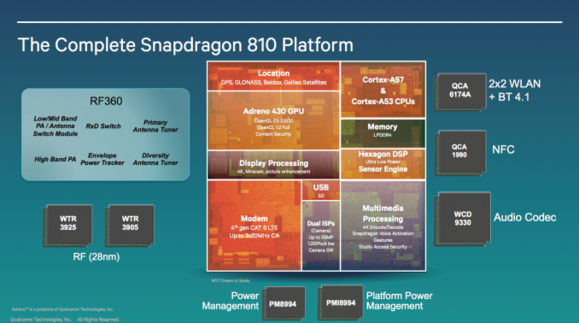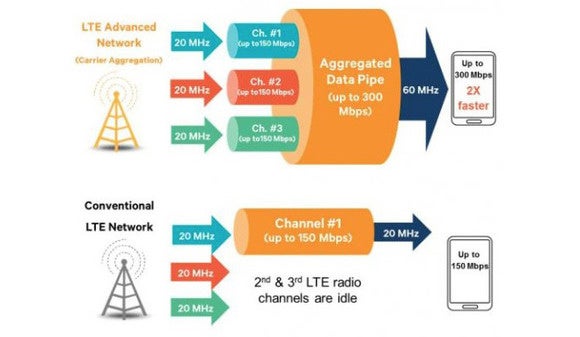Qualcomm absolutely dominates the market for premium mobile processors based on the ARM architecture. Even market segments that have traditionally been the domain of cheaper parts have been infiltrated by some of Qualcomm’s newer offerings like the Snapdragon 400 200 series.
This brings us to the coming generation of 64-bit chips, at the top of the heap is the Snapdragon 810. This is the chip that will power many of the top phones of 2015, but it’s a significant departure for Qualcomm. Here’s everything you need to know about the 810.
More Cs, with less customization
Qualcomm rose to dominance on the strength of its custom ARM-compatible C cores. st like Nvidia, Qualcomm purchased an instruction set license from ARM Holdings to design its own cores that are compatible with ARM software. The first generation of custom Cs from Qualcomm were called Scorpion, which powered the original Snapdragon. After that we moved on to multiple Cs in the Krait family. The Snapdragon 810 is different because it’s not running a custom C designed by Qualcomm—the Snapdragon 810 is powered by eight ARM reference cores.

Everything you need in one neat package.
If you’re familiar with the Nvidia Tegra X1, this will sound eerily familiar—that chip dropped Nvidia’s custom “Denver” processor cores for ARM designs. The Snapdragon 810 is running four Cortex-A57 four Cortex-A53 cores. The A57 is a high-performance core that consumes more power than the slower, hyper-efficient A53 core. This isn’t the first time Qualcomm has used the ARM reference designs in a newer system-on-a-chip (SoC), but this is the first high-end chip to do so.
Ignoring the issue of whether or not it’s necessary to move to 64-bit hardware on mobile devices, the software is there it has become one of those checkboxes people expect to see on a spec sheet. The problem for Qualcomm is that its custom 64-bit C core isn’t ready for primetime yet. Rumors point to an updated design based on the 64-bit ARMv8-A instruction set coming in the Snapdragon 820 late this year.
The 810 is built on a 20nm manufacturing process (that’s a measurement of the relative size of the features on the chip). This is the same process technology used to build Nvidia’s Tegra X1 chip a step up from Qualcomm’s most recent custom chip, the 805 (which used a 28nm process). The 20nm tech makes the 810 more efficient, allowing more transistors in smaller space, but moving to the 64-bit instruction set will also improve efficiency. The company isn’t offering exact power consumption number for the chip yet but rumors point to about 3 watts for phones. That’s probably lower than Nvidia can get the Tegra X1.
The Tegra X1 has a similar setup of C cores, but Qualcomm is using ARM’s big.TT core management scheme. The “big” half of that is the A57 cores, the “TT” refers to A53. Many older “octa-core” mobile Cs were cheating by only having one of the four-core isls operating at a time, but the Snapdragon 810 could be called a true octa-core chip.
The Snapdragon 810 supports global task scheduling, sometimes called heterogeneous multi-processing (HM. That means the system can see each of those eight cores as an independent element can assign workloads dynamically across them. Any mix of cores can be operational at a given time, depending on what the system is doing.
Of course, that means you need a way of moving data between those cores. There’s a bit of silicon on the SoC (probably a CCI-400, or coherent cache interface) that keeps the cache visible to various components, including the C cores G, so they don’t have to go back to main memory as often.

ARM’s most advanced big.TT technology is at work in the Snapdragon 810.
So what does that do for you as a user? Imagine this— while your Snapdragon 810-powered phone is asleep, a Cortex-A53 might be running a background process using very little power. Then an app triggers a system alarm so it can wake up sync some data. Suddenly, a Cortex-A57 core comes online to do its thing without interrupting what the A53 is doing. th the hard work done, the A57 passes the task off to another A53 goes back to sleep. Clever, right?
Sound video
ile Qualcomm is going to ARM for its C cores this time, it’s still rocking an in-house G from the Adreno family. Most other octa-core chips with the A57/A53 big.TT setup will use ARM’s Mali G designs, but the new Adreno 430 in the Snapdragon 810 promises to push pixels like no one’s business.
The Adreno 430 will be clocked to 650Mhz, just a bit faster than the older 420. However, Qualcomm expects the 430 to be about twice as fast when it comes to G compute applications, 30% faster in 3D performance when compared to the 420. wer usage is reportedly 20% lower too. don’t have much more detail on the Adreno 430 itself because Qualcomm remains unwilling to exp on architectural features of its G. Nvidia provides an obscene amount of data on the Tegra X1’s G, but that’s because Nvidia is a G maker first foremost. It’s in Nvidia’s interests to talk about how cool the Maxwell G architecture is.
Instead of getting into the technical design of the Adreno 430, Qualcomm has been talking about what it will be able to do. The Adreno 430 will be capable of pushing external native 4k resolution displays. Qualcomm is actually hoping OEMs will make 4k a big selling point on 810-powered devices. This chip will include dedicated HEVC/H.265 hardware allowing it to natively play, record, stream 4K content (at 4-6 Gbps). There’s even a reference design for an HDMI dongle that can stream 4k video from a device to a TV as it’s being recorded.

The 810 will be able to hle simultaneous 4K native external displays.
There are already plenty of devices that can record 4k video, but the 810’s dedicated hardware will be able to compress the files more efficiently for better battery life less heat generation. If you’ve ever recorded 4k video on a phone, you know how toasty they get. Consumers haven’t yet embraced 4k video content, largely because of the lack of sufficiently high-resolution displays. That might be changing in the next year as 4k TVs come down in price, Qualcomm will be ready.
so on board the Snapdragon 810 is all the hardware necessary for a high-end audio experience—both input output. Audio processing hardware in the 810 will support Dolby Atmos for enhanced virtual surround sound higher fidelity playback, assuming OEMs take advantage of it. It also makes better use of multiple microphones when recording video to get an accurate audio track.
Qualcomm’s coolest audio trick comes thanks to the Hexagon v56 DS(digital signal processor). This component of the chip enables always-on listening modes for voice comms. That’s how devices like the Nexus 6 2014 Moto X can wake up from sleep mode when they hear a certain phrase. In the past this sort of functionality required additional hardware, but all Snapdragon 800-series SoCs have this built in. Again, it’s up to phone makers to implement these features because the As are not exposed to third-party app developers.
Signal strength is a strength
By all accounts, Qualcomm has built an extremely competitive chip when it comes to crunching bits pushing pixels, but there’s one more element of the 810 that will make it a staple of 2015 Android devices: the modem. Qualcomm’s Gobi modems are frequently chosen by OEMs during the design process due to their extensive b support. Most Qualcomm SoCs (including the 810) have the modem built into the chip.
The modem used in a device determines which cellular bs it can operate on, but the patchwork nature of cellular frequencies means there are a lot of bs to support around the world. Qualcomm’s modems tend to support a plethora of bs in a single piece of hardware. If device makers can equip a phone with the right power amplifiers, it could connect to almost anything thanks to these modems. For example, the Snapdragon 805-powered Nexus 6 has support for a whopping 12 E bs. A few years ago having more than three or four was almost unheard of. This makes tuning devices for one carrier or another much easier.

Carrier aggregation in the 810 allows for much higher data speeds.
The E-Advanced Gobi modem built into the main Snapdragon 810 variant will be even beefier than past versions. It supports E Category 9 Carrier Aggregation connectivity, meaning it can operate simultaneously over three 20MHz bs with different carrier signals. This can result in huge gains in bwidth on carriers that have their E capacity split across multiple bs.
Running multiple E frequencies is becoming increasingly common. l the major carriers are operating E on at least two different bs now, in some cases three. Qualcomm says the Snapdragon 810 can hit a maximum (theoretical) download speed of 450 Mbps (although some documentation says it’s only 300). Even if it’s only a fraction of that in real life, it’s still impressive.
Snapdragon 810: Hot or not?
Qualcomm has been facing some nasty rumors about the Snapdragon 810 causing heat issues in early testing, but the company hasn’t responded directly to the rumors yet. It did note in its recent financial report that a large OEM partner would not be using the Snapdragon 810 in a popular upcoming phone, but more than 60 devices will ship with the 810 this year. No one knows for sure right now if that count will include the Samsung Galaxy S6, but it is assumed that this is the dropped phone Qualcomm was talking about.

New Snapdragon 810 vs. Snapdragon 805.
Qualcomm has a ton of experience making highly efficient chips for phones tablets. ile Nvidia’s Tegra X1 might finally take a bite out of the tablet market, Qualcomm is still going to dominate phones with the Snapdragon 810. Distinct hardware features like the Hexagon DS near-universal E-Advanced modem put the 810 in a good place, the newest implementation of ARM’s multi-core management tech won’t hurt either.
















